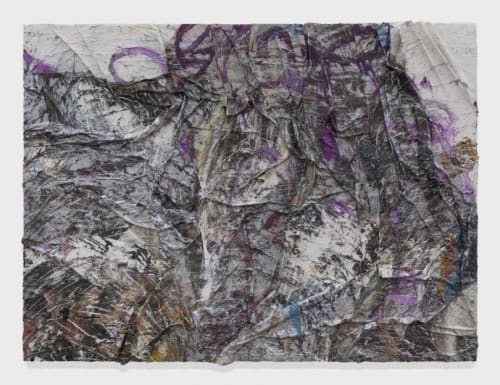This painting is based on Nicolas Poussin’s Destruction of the Temple of Jerusalem. For the past few months, I’ve been taking Poussin as a straight reference and reproducing some of his paintings in the process of making my own. This one is huge, about 6 feet high by 8 feet long.
To make it, I began copying the Poussin in oil paint onto a large glass plate. I also added gestural marks over the areas that had already been painted, and then I went back and on top of those marks I painted some of the people in the poussin—I go back and forth, layering representational painting and abstract marks. When the painting is done, I cover it with a thick layer of oil paint and leave it to dry for about a month. after, I use blades, which i’ve had specially made, to scrape the paint off the glass in large skins, and this distorts the imagery into something pretty abstract. These paint skins then dry on cardboard and are eventually collaged on canvas. The wrinkling that you see skins sliding down the cardboard.
The process is very delicate. it creates a dialogue between the conventional and the unconventional, between what painting can and cannot be. My impulse is to test the possibilities of painting to its core, using the most traditional mediums, so you have an interesting tension between the history of oil painting with all its expectations and something more unexpected, almost totally uncontrolled.
I got to thinking about poussin while reading about Cy Twombly and all the similarities that they had, starting with the fact that they each moved to Rome from someplace else to paint. When I started looking at those similarities, I wanted to accommodate myself to that conversation. Poussin was obsessed with color, and at the same time he struck this balance between what his patrons wanted and the things he was interested in. I’m also interested in the way he at times imitated poses from Roman sculptures and the various gestures he used in his paintings to represent different subjects, be they mythological or religious. I try to relate to him from a contemporary perspective, from my interest in layering many approaches.

